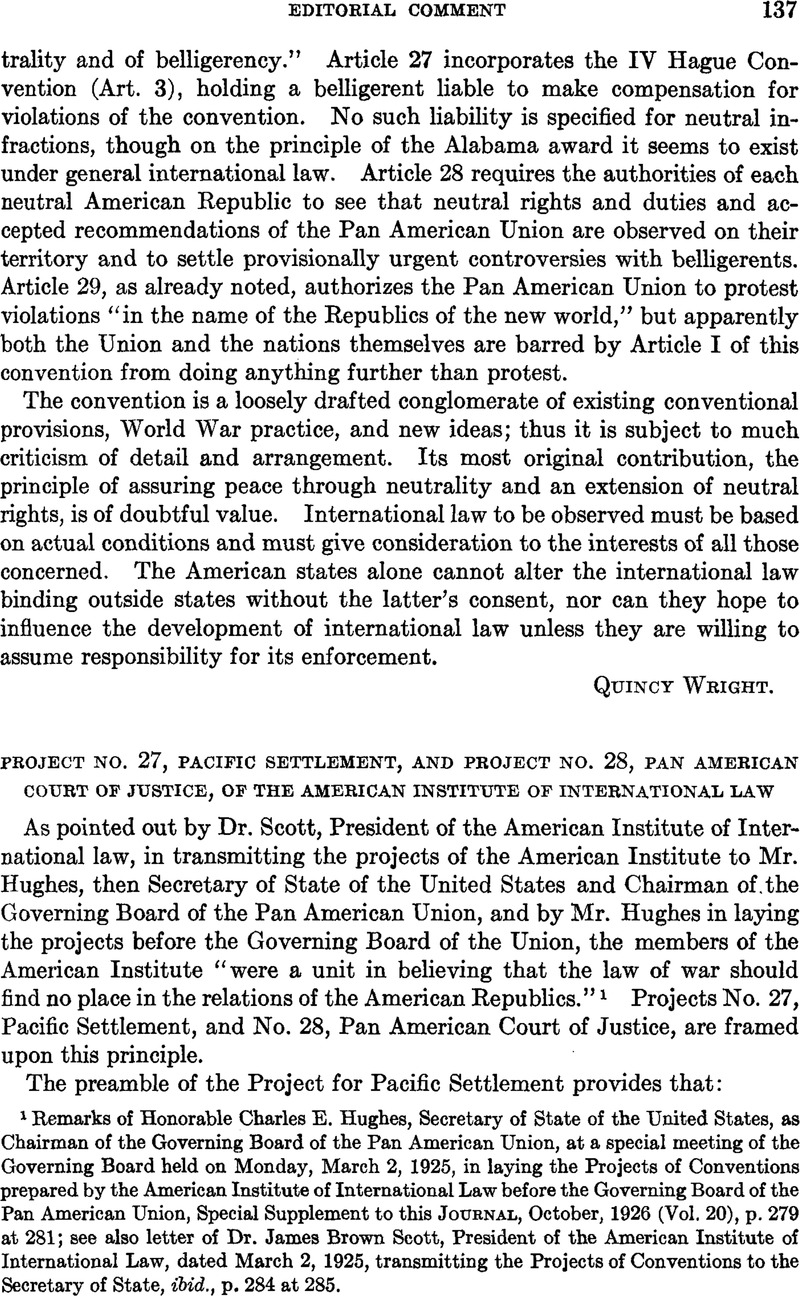No CrossRef data available.
Published online by Cambridge University Press: 04 May 2017

1 Remarks of Honorable Hughes, Charles E., Secretary of State of the United States, as Chairman of the Governing Board of the Pan American Union, at a special meeting of the Governing Board held on Monday, March 2, 1925, in laying the Projects of Conventions prepared by the American Institute of International Law before the Governing Board of the Pan American Union, Special Supplement to this Journal , October, 1926 (Vol.20), p. 279 at 281;Google Scholar see also letter of Dr.Scott, James Brown,President of the American Institute of International Law, dated March 2, 1925, transmitting the Projects of Conventions to the Secretary of State, ibid., p.284at 285 Google Scholar
2 Project No. 27, Pacific Settlement, Special Supplement to this Journal, October, 1926(Vol. 20), p. 368.
3 See Holls, The Peace Conference at The Hague, pp. 196-203.
4 It should be noted, however, that Article 7 provides that “ in case of dispute none of the parties shall begin mobilization or concentration of troops on the frontier of the other, nor engage in any hostile act or preparation for hostilities from the time steps are taken to convene the commission until the said commission has rendered its report, or until the expiration of the time provided for in Article 18.” Is the implication of this provision quite consistent with the spirit of the preamble? Is not Article 15, which provides for the maintenance of the status quo, sufficient?
5 U. S. Treaty Series, No. 717; supplement to this Journal , Vol. 17 (1923), p. 108.
6 Protocol for the Arbitration of the Alsop Claim, December 1, 1909, Foreign Relations,1910, p. 186; Treaties and Conventions, Vol. 3, p. 2508; this Journal , Vol. 5 (1911),p. 1080.
7 See Proceedings of the American Society of International Law, 1920, p. 44 et seq. See also the Costa Rican plan for a Pan American Court of Justice, Special Supplement to this Journal , October, 1926, p. 385.
8 (Article 3). An appeal on matters of law lies from the Court of First Instance to the Court of Appeal (Article 41). In each court dissenting members may make their dissent and the reasons therefor of record (Articles 38-41). This last is a most necessary provision.Compare the language of the Hague Convention of 1899, Article 52, with the corresponding Article of the Hague Convention of 1907, Article 79.
9 Annex to the first opinion expressed by the Second Peace Conference; Draft convention relative to the creation of a juridical arbitration court, Part 1, Article 1, Scott's Texts of the PeaceConference of The Hague, p. 141.
10 Hague Project, Article 9, A. S. I. L. Proceedings, 1920, p. 44 at 48.
11 The Antelope (1825), 10 Wheat. 66, 122.
12 Convention concerning the boundary waters between the United States and Canada,signed at Washington, January 11, 1909, U. S. Treaty Series, No. 548; Treaties and Conventions,Vol. 3, p. 2607 at 2611; Supplement to this Journal , Vol. 4 (1910), p. 239.
13 In the protocol between the United States and Venezuela providing for the submission of the Orinoco Steamship Case to the Hague Tribunal (Treaties, Conventions, International Acts, etc., Vol. 2, p. 1881; Supplement to this Journal , Vol. 3 (1909), p. 224.) provision was made for three official languages, English, Spanish and French,“ in the presentation of cases ” by the parties. There was no express provision as to the language to be used by the court. It was probably thought that this provision might bring about the exclusive adoption of French as the neutral language by common consent; but it did not happen that way.The United States selected a judge familiar with all three of the official languages. Venezuela appointed a judge who knew only French. The court ruled that it would use the English and French languages during the discussion. Documents were before the court in three languages. The American Agent and Counsel addressed the court in English, the Venezuelan Agent was compelled to speak in French and to decline the humorous but bona fide offer of the American Agent, made out of court, that the Venezuelan Agent and one of American counsel should address the court in Spanish, on the ground that such an address could only be understood by the member of the court who had been named by the United States. (See this Journal , Vol. 5 (1911), p. 59.) Interpreters are not only an expensive and time consuming nuisance, but often a substantial impediment at arriving at the truth. Unless international justice is to be in large part administered by men whose accomplishments are linguistic rather than legal two official languages for a permanent court (as distinguished from a panel court) are all that the traffic will bear.